Code 3 CommandStik Torus Single-Color Troubleshooting guide
- Category
- Motor vehicle electronics
- Type
- Troubleshooting guide
This manual is also suitable for

INSTALLATION
& OPERATION
MANUAL
CommandStik™
CONTENTS:
Introduction ..................................................................................... 2
Unpacking & Pre-Installation ..........................................................2
Installation & Mounting ...................................................................3
Wiring Instructions .......................................................................3-4
Flash Pattern Selection .................................................................5
Troubleshooting .............................................................................5
Exploded View-Parts List ................................................................ 6
Notes ..............................................................................................7
Warranty .........................................................................................8
For future reference record your product's serial no. here __________________________________________
Read all instructions and warnings before installing and using.
This manual must be delivered to the end user of this equipment.
IMPORTANT:
INSTALLER:
CommandStik™ with Torus™ Technology
Interior Lighting System
REAR DECK LIGHT BAR

2
Unpacking & Pre-installation
Carefully remove the CommandStik and place it on a at surface, taking care not to scratch the lenses or damage the cable coming out
of the top. Examine the unit for transit damage, broken lamps, etc. Report any damage to the carrier and keep the shipping carton.
Standard light bars are built to operate on 12 volt D.C. negative ground (earth) vehicles. If you have an electrical system other than 12
volt D.C. negative ground (earth), and have not ordered a specially wired light bar, contact the factory for instructions.
Test the unit before installation. To test, touch the black wire to the ground (earth) and the other wires to +12 volts D.C., in accordance
with the instructions attached to the cable (an automotive battery is preferable for this test). A battery charger may be used, but note that
some electronic options may not operate normally when powered by a battery charger. If problems occur at this point, contact the factory.
Note: Before beginning the installation process, be absolutely certain
that the Light Bar functions as desired (See page 3 & 4 for options)!
Mounting Hardware - All mounting hardware is packed in a small bag inside the main carton. There are two brackets used to mount
the CommandStik to the vehicle. These are discussed in detail later.
Introduction
The CommandStik with Torus Technology is an interior lighting system that ts in the rear deck area. The CommandStik has room for
up to eight Torus light heads.
Product Features
Torus light head options: Red, Blue, Amber, and White-----------------------Flashing
Size: 27.50" long x 1.25" tall x 3.50" deep----------------------------------------Weight: 4.5 lbs
The use of this or any warning device does not ensure that all drivers can or will observe or react to an
emergency warning signal. Never take the right-of-way for granted. It is your responsibility to be sure you can
proceed safely before entering an intersection, driving against trafc, responding at a high rate of speed, or
walking on or around trafc lanes. The effectiveness of this warning device is highly dependent upon correct
mounting and wiring. Read and follow the manufacturer’s instructions before installing or using this device. The
vehicle operator should insure daily that all features of the device operate correctly. In use, the vehicle operator
should insure the projection of the warning signal is not blocked by vehicle components (i.e.: open trunks or
compartment doors), people, vehicles, or other obstructions. This equipment is intended for use by authorized
personnel only. It is the user’s responsibility to understand and obey all laws regarding emergency warning
devices. The user should check all applicable city, state and federal laws and regulations. Code 3, Inc., assumes
no liability for any loss resulting from the use of this warning device. Proper installation is vital to the performance
of this warning device and the safe operation of the emergency vehicle. It is important to recognize that the
operator of the emergency vehicle is under psychological and physiological stress caused by the emergency
situation. The warning device should be installed in such a manner as to: A) Not reduce the output performance
of the system, B) Place the controls within convenient reach of the operator so that he can operate the system
without losing eye contact with the roadway. Emergency warning devices often require high electrical voltages
and/or currents. Properly protect and use caution around live electrical connections. Grounding or shorting of
electrical connections can cause high current arcing, which can cause personal injury and/or severe vehicle
damage, including re. Any electronic device may create or be affected by electromagnetic interference. After
installation of any electronic device operate all equipment simultaneously to insure that operation is free of
interference. Never power emergency warning equipment from the same circuit or share the same grounding
circuit with radio communication equipment. All devices should be mounted in accordance with the manufacturer's
instructions and securely fastened to vehicle elements of sufcient strength to withstand the forces applied to the
device. Driver and/or passenger air bags (SRS) will affect the way equipment should be mounted. This device
should be mounted by permanent installation and within the zones specied by the vehicle manufacturer, if any.
Any device mounted in the deployment area of an air bag will damage or reduce the effectiveness of the air
bag and may damage or dislodge the device. Installer must be sure that this device, its mounting hardware and
electrical supply wiring does not interfere with the air bag or the SRS wiring or sensors. Mounting the unit inside
the vehicle by a method other than permanent installation is not recommended as unit may become dislodged
during swerving, sudden braking or collision. Failure to follow instructions can result in personal injury. PROPER
INSTALLATION COMBINED WITH OPERATOR TRAINING IN THE PROPER USE OF EMERGENCY WARNING
DEVICES IS ESSENTIAL TO INSURE THE SAFETY OF EMERGENCY PERSONNEL AND THE PUBLIC.
WARNING!
Utilizing non-factory supplied screws and/or mounting brackets and/or the improper
number of screws may result in loss of warranty coverage on the equipment.
WARNING!

3
Installation Instructions
Step 1 Assemble the mounting brackets to the CommandStik with the the supplied 1/4"-20 screws and internal tooth lock washers and
tighten the screws nger tight (see page 6 for orientation).
Step 2 Using the CommandStik assembly as a template, locate the CommandStik in the desired location for the light bar in the vehicles
rear deck area and mark the location of the customer supplied carriage bolts using the square holes in the CommandStik 90 degree mounting
brackets. Note: The square holes in the CommandStik's 90 degree mounting brackets are sized for 1/4-20 carriage bolts.
Step 3 Drill the required mounting holes through the vehicles fabric and sheet metal to provide a hole for the customer supplied mounting
bolts. Note: in many cases some sort of spacer will be required between the vehicle's fabric and it's sheet metal to keep the fabric
from collapsing as you tighten the hardware. The spacer should be made out of a suitable plastic or metal for safety.
Step 4 Install the customer supplied carriage bolts, washers and lock washers through the square holes in the CommandStik's 90 degree
mounting brackets and through the holes in the vehicle's rear deck fabric and sheet metal and tighten all fasteners securely.
Caution: Drilling into the housing of the light bar could damage wiring or other internal components.
Wiring Instructions
It is advisable to leave an extra loop of cable when installing the light bar to allow for future changes or reinstallations. Connect
the black lead to a solid frame ground (earth), preferably the (-) or ground (earth) side of the battery, and the power wire to the +12V
terminal of the battery. Connect the remaining wires as shown below on this page and on page 4.
Larger wires and tight connections will provide longer service life for components. For high current wires it
is highly recommended that terminal blocks or soldered connections be used with shrink tubing to protect
the connections. Do not use insulation displacement connectors (e.g. 3M
®
Scotchlock type connectors).
Route wiring using grommets and sealant when passing through compartment walls. Minimize the
number of splices to reduce voltage drop. High ambient temperatures (e.g. under hood) will signicantly
reduce the current carrying capacity of wires, fuses, and circuit breakers. Use "SXL" type wire in engine
compartment. All wiring should conform to the minimum wire size and other recommendations of the
manufacturer and be protected from moving parts and hot surfaces. Looms, grommets, cable ties, and
similar installation hardware should be used to anchor and protect all wiring. Fuses or circuit breakers
should be located as close to the power takeoff points as possible and properly sized to protect the wiring
and devices. Particular attention should be paid to the location and method of making electrical connections
and splices to protect these points from corrosion and loss of conductivity. Ground terminations should
only be made to substantial chassis components, preferably directly to the vehicle battery. The user should
install a fuse sized to approximately 125% of the maximum Amp capacity in the supply line to protect
against short circuits. For example, a 30 Amp fuse should carry a maximum of 24 Amps. DO NOT USE
1/4" DIAMETER GLASS FUSES AS THEY ARE NOT SUITABLE FOR CONTINUOUS DUTY IN SIZES
ABOVE 15 AMPS. Circuit breakers are very sensitive to high temperatures and will "false trip" when
mounted in hot environments or operated close to their capacity.
WARNING!
Wiring Diagram - STANDARD NON ARROWSTIK®
GREEN (PATTERN SELECT)
WHITE (DIMMING)
RED (POWER)
YELLOW (
LEVEL 3
)
ORANGE (LEVEL 2)
BLUE (LEVEL 1)
BLACK (GND)
FUSE WITH CUSTOMER SUPPLIED 10 AMP FUSE

4
Wiring Diagram - WITH ARROWSTIK®
GREEN (PATTERN SELECT)
WHITE (DIMMING)
RED (POWER)
YELLOW (RIGHT ARROW)
ORANGE (LEFT ARROW)
BLUE (LEVEL 1)
BLACK (GND)
THESE WIRES MAY BE
SWAPPED IF ARROW
DIRECTION IS NOT
AS DESIRED
This Product contains high intensity Torus devices. To prevent eye damage,
DO NOT stare into light beam at close range.
WARNING!
6 HEAD ARROWSTIK W (2) OUTER LIGHT HEADS FLASHING ALTERNATELY
The CommandStik can be congured as a 6 or 8 head ArrowStik. To change the CommandStik from an 8 head ArrowStik to
a 6 Light Head conguration with the (2) Outboard Light Heads ashing alternately, remove the mounting screws that attach
the CommandStik's Cover to the Outer Panel to gain access to the printed circuit board inside (see the exploded view on page
6). Move the Shunt Option Jumper (JP1) on the printed circuit board to the "OPTION JP1" position as shown below. When
congured for a 6 head operation, the (2) Outboard Light Heads will alternate during any ArrowStik mode. Carefully replace the
CommandStik's Cover over the Outer Panel and replace the Cover Mounting Screws.
Note: Be extremely careful to replace the wiring such that you don't pinch a wire when you
replace the CommandStik's Cover. Test the unit to be sure that it works properly.
<---------------"OPTION JP1" Jumper Position

5
Flash Patterns
STANDARD LIGHT HEAD FLASH PATTERNS
PATTERN NO PATTERN DESCRIPTION
1 FAST ALTERNATING QUAD FLASH 100ms/25ms
2 PICKET FENCE SINGLE FLASH 200ms/25ms
3 ALTERNATING SINGLE FLASH 200ms/25ms
4 PICKET FENCE QUAD FLASH 100ms/25ms
5 PICKET FENCE SIX FLASH 75ms/25ms
6 SLOW ALTERNATING QUAD FLASH 150ms/50ms
7 SLOW ALTERNATING SIX FLASH 125ms/25ms
8 FAST ALTERNATING SIX FLASH 75ms/25ms
9 VARIABLE RATE PICKET FENCE, SINGLE FLASH
10 ALTERNATING QUAD FLASH, 80 FPM, NFPA COMPLIANT
11 CYCLE FLASH
12 SIMULTANEOUS QUAD FLASH, 75 FPM, NFPA COMPLIANT
ARROWSTIK FLASH PATTERNS
PATTERN NUMBER PATTERN DESCRIPTION
1
2
3
4
5
6
7
8
9
10
11
12
Building, Fast Speed
Building, Medium Speed
Building, Slow Speed
Building, 3 Flash, Fast Speed
Building, 3 Flash, Medium Speed
Building, 3 Flash, Slow Speed
Traveling Ball, 3 Flash, Fast Speed
Traveling Ball, 3 Flash, Medium Speed
Traveling Ball, 3 Flash, Slow Speed
Build/Collapse, Fast Speed
Build/Collapse, Medium Speed
Build/Collapse, Slow Speed
Torus Light Head Flash Pattern
To change the ash patterns of the Torus Light Heads for either Standard or ArrowStik patterns, activate the Light
Bar in Level 1 or any ArrowStik mode and then momentarily touch the Green (Pattern Select) wire to +power.
Repeating this procedure allows the operator to cycle through the numerous ash patterns offered until the desired
pattern is achieved. Repeat for all modes as needed.
Note: Each ArrowStik mode must be set individually.
To reset the ash patterns to the factory default, activate the Light Bar in Level 1 or any ArrowStik mode and then
hold the Green (Pattern Select) wire to +power for approximately 4 seconds.
Note: 1-Resetting the Standard patterns will reset only the Level 1 ash patterns
2-Resetting the ArrowStik patterns in any ArrowStik mode will reset all ArrowStik ash patterns.
Troubleshooting
All CommandStik Products are thoroughly tested prior to shipment. However, should you encounter a problem during installation
or during the life of the product, follow the guide below for information on repair and troubleshooting. Additional information may be
obtained from the factory technical help line at 314-996-2800. Follow the guide below for information on repair and troubleshooting.
TROUBLESHOOTING GUIDE
QUESTIONS POSSIBLE CAUSE
a. Bad power/ground
connection.
b. Defective module.
SOLUTION
a. Fix connection.
b. Replace module
N/A
PROBLEM
Torus™ Module
not operating when
powered.
Flash Pattern Changes

6
Parts List
Reference Number Part Description Part Number Qty
1 Outer Panel T15552 1
2 Chassis T15551 1
3 AS-10 Universal Mounting Bracket S50008 2
4 Torus™ Module *Contact Code 3, Inc for P/N Up to 8
5 .625 Diameter Cap T04797 2
6 Circuit Board Assembly T11568 1
7 Internal tooth starwasher .250 T06935 4
8 1/4-20 x 3/8" Phil Pan Hd, Black Zinc, Stl T89965 4
9 .750 Diameter Cap T00232 2
1
2
5
4
3
6
9
5
8
7

7
Notes

Revision 0, 10/04/2012 - Instruction Book Part No. T15553
©2012 Code 3, Inc. Printed in USA
PRODUCT RETURNS
If a product must be returned for repair or replacement*, please contact our factory to obtain a Return
Goods Authorization Number (RGA number) before you ship the product to Code 3, Inc. Write the RGA number
clearly on the package near the mailing label. Be sure you use sufcient packing materials to avoid damage to
the product being returned while in transit.
*Code 3, Inc. reserves the right to repair or replace at its discretion. Code 3, Inc. assumes no responsibility or liability for expenses incurred for the removal and /or
reinstallation of products requiring service and/or repair.; nor for the packaging, handling, and shipping: nor for the handling of products returned to sender after the service has been
rendered.
Code 3®, Inc.
10986 N. Warson Road
St. Louis, Missouri 63114-2029—USA
Ph. (314) 426-2700 Fax (314) 426-1337
www.code3pse.com
NEED HELP? Call our Technical Assistance HOT LINE - (314) 996-2800
Code 3 is a registered trademark of Code 3, Inc. a subsidiary of Public Safety Equipment, Inc.
WARRANTY
This product with TriCore® or Torus™ Technology was tested and found to be operational at the
time of manufacture. Provided this product is installed and operated in accordance with the manufacturer's
recommendations, Code 3®, Inc. warrants all parts and components (with the exception of all incandescent and
halogen bulbs) of the product to be free of defects in material and workmanship for a period of one (1) year and
TriCore or Torus™ light heads for a period of ve (5) years from the date of purchase. This Warranty excludes
normal wear & tear. Units demonstrated to be defective within the warranty period will be repaired or replaced
at the factory service center at no cost. Code 3, Inc. will return the repaired product with transportation cost
prepaid. Code 3, Inc. assumes no liability for expenses incurred in the packaging, handling, and shipping of
the product to the Factory Technical Service Department for repair. For in-warranty product return authorization,
questions regarding product warranty coverage or questions regarding out-of-warranty repair quotes, contact
the Factory Technical Service Department.
The TriCore light heads are sealed as part of the quality control process. This Warranty is void if, in the
judgment of Code 3, Inc. (1) an attempt has been made to break the light head seal or repair the light head,
and/or (2) the product has been used with inappropriate or inadequate wiring or circuit protection, and/or (3)
the product has failed as a result of abuse or unusual use and/or accidents.
CODE 3, INC. SHALL IN NO WAY BE LIABLE FOR ANY OTHER DAMAGES RELATING TO THE
PRODUCT INCLUDING BUT NOT LIMITED TO CONSEQUENTIAL, INCIDENTAL, INDIRECT OR SPE-
CIAL DAMAGES OR LOST PROFITS OR REVENUE; NOR ANY EXPENSES INCURRED IN THE REMOV-
AL AND/OR RE-INSTALLATION OF PRODUCTS REQUIRING SERVICE AND/OR REPAIR.
EXCEPT AS SET FORTH ABOVE, CODE 3, INC. MAKES NO OTHER EXPRESS OR IMPLIED
WARRANTIES WHATSOEVER, INCLUDING, WITHOUT LIMITATION, WARRANTIES OF FITNESS FOR A
PARTICULAR PURPOSE OR MERCHANTABILITY, WITH RESPECT TO THIS PRODUCT.
-
 1
1
-
 2
2
-
 3
3
-
 4
4
-
 5
5
-
 6
6
-
 7
7
-
 8
8
Code 3 CommandStik Torus Single-Color Troubleshooting guide
- Category
- Motor vehicle electronics
- Type
- Troubleshooting guide
- This manual is also suitable for
Ask a question and I''ll find the answer in the document
Finding information in a document is now easier with AI
Related papers
-
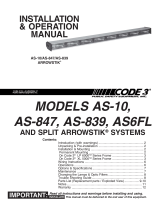 Code 3 ARROWSTIK AS-839 Specification
Code 3 ARROWSTIK AS-839 Specification
-
 Code 3 Matrix Lightbar Installation And Operation Instructions Manual
Code 3 Matrix Lightbar Installation And Operation Instructions Manual
-
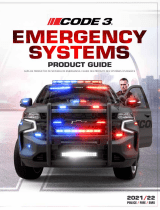 Code 3 Emergency Systems 2021 User guide
Code 3 Emergency Systems 2021 User guide
-
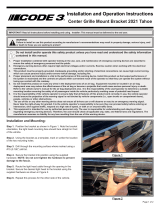 Code 3 2021 Tahoe Center Grille Bracket Install Instructions
Code 3 2021 Tahoe Center Grille Bracket Install Instructions
-
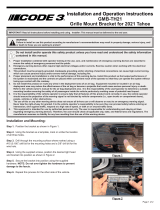 Code 3 2021 Tahoe Grille Bracket Install Instructions
Code 3 2021 Tahoe Grille Bracket Install Instructions
-
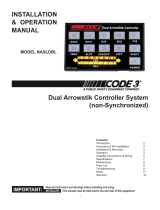 Code 3 NASLDBL Install Instructions
Code 3 NASLDBL Install Instructions
-
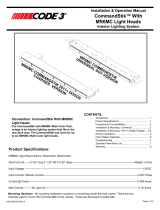 Code 3 CommandStik MR6MC Install Instructions
Code 3 CommandStik MR6MC Install Instructions
-
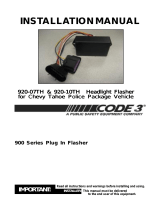 Code 3 920 Install Instructions
Code 3 920 Install Instructions
-
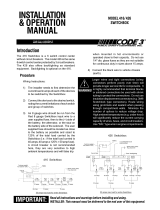 Code 3 RockerPak Install Instructions
Code 3 RockerPak Install Instructions
-
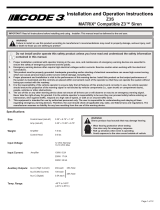 Code 3 Serial Siren Install Instructions
Code 3 Serial Siren Install Instructions
Other documents
-
GE Incandescent Look Installation guide
-
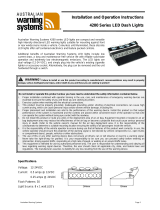 Australian Warning Systems 4200 Series Installation and Operation Instructions
Australian Warning Systems 4200 Series Installation and Operation Instructions
-
FENCE4EVER F4E-B850FS-A-90 Operating instructions
-
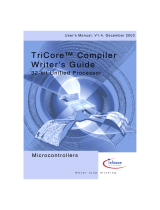 Infineon Technologies TriCore Compiler User manual
Infineon Technologies TriCore Compiler User manual
-
EDWARDS 113 Series Installation guide
-
Fezz Audio Torus 5040 User manual
-
Patlite LP8US Installation guide
-
Autodesk Maya 2009 Quick Start
-
Autodesk Maya 2010 Quick Start
-
Autodesk AutoCAD for Macintosh 2011 Operating instructions



















